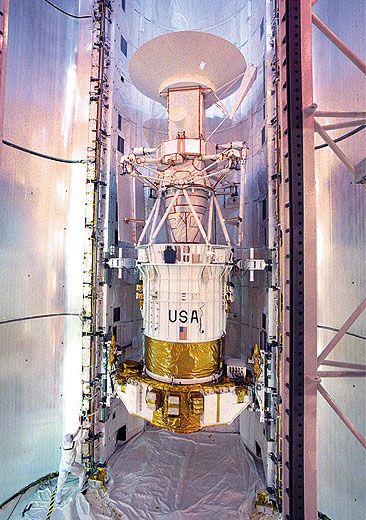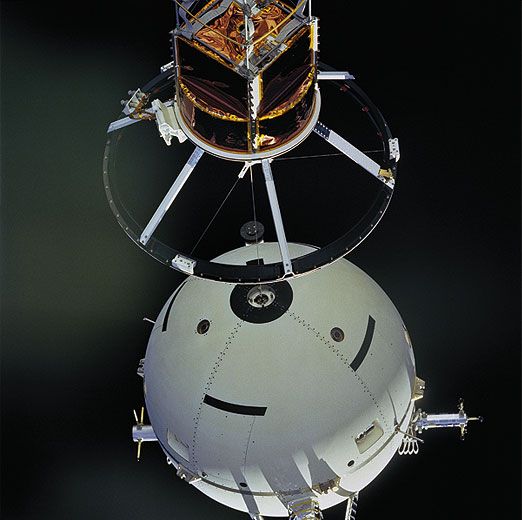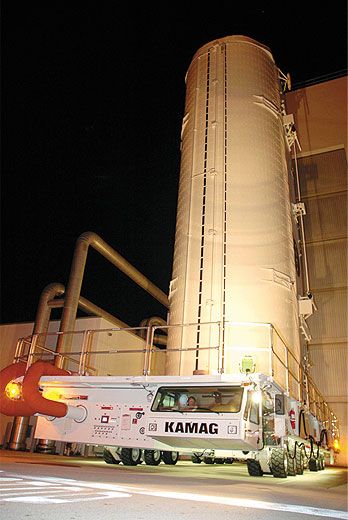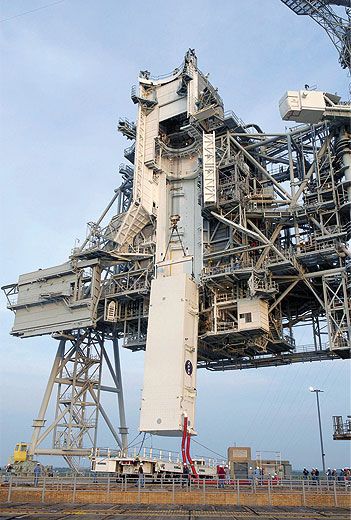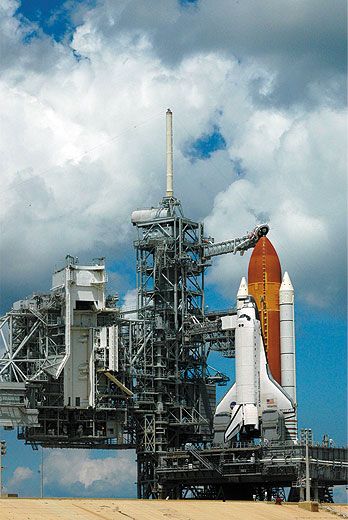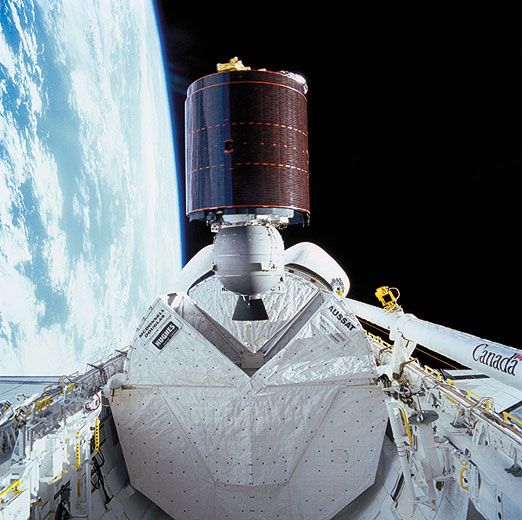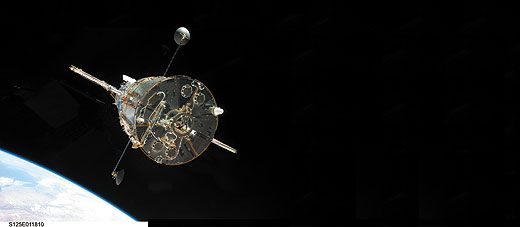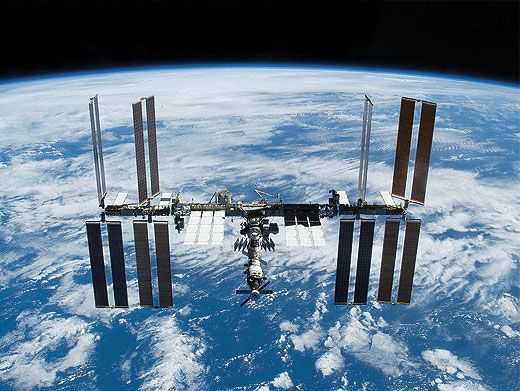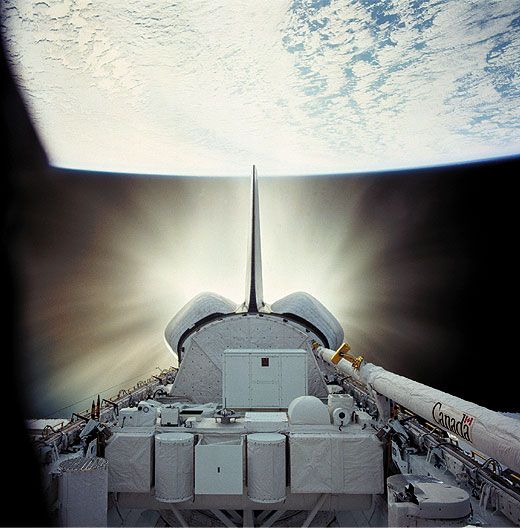The Truck
Satellites, experiments, space station parts - the space shuttle hauled it all.
/https://tf-cmsv2-smithsonianmag-media.s3.amazonaws.com/filer/The_Truck_FLASH_AUG2010.jpg)
The shuttle was the king of multi-tasking. On its final missions this year, it will continue its work as a people mover and space station supplier, but over its career, the shuttle was a heavy lifter, carrying more than 100 primary payloads to orbit. Its cargo bay—60 feet long, 15 feet wide—was built to satisfy the National Reconnaissance Office, which wanted to make sure its biggest satellites could go. Though the bay could carry up to 54,000 pounds, no payload hit that number (the closest: a 46,500-pound NASA Tracking and Data Relay Satellite launched in September 1988). Its greatest strength was versatility: Only the shuttle could put something in orbit, then go get it and bring it back.
Tourists to Other Worlds
In quick succession, the shuttle sent three interplanetary probes on their way from the cargo bay within an 18-month period in 1989 and 1990. Magellan, a radar mapper bound for Venus, was launched in May 1989. That October, a shuttle started Galileo on its voyage to Jupiter. Both probes used Boeing-built Inertial Upper Stages to get to their destinations. The following October, Ulysses, a probe jointly run by NASA and the European Space Agency, left the shuttle cargo bay with two upper stages—an IUS and a Payload Assist Module—to boost it into orbit around the sun. The Jet Propulsion Laboratory in Pasadena, California, had built all three interplanetary explorers to the cargo bay’s dimensions.
Science Projects
The pressurized module Spacelab, which flew two dozen times in the 1980s and 1990s, turned the shuttle’s cargo bay into a round-the-clock lab, with astronauts on 12-hour shifts (a similar commercial module, SPACEHAB, flew almost as many times). In April 1984, a crew deployed the school-bus-size Long Duration Exposure Facility with 57 experiments; it was retrieved in January 1990. One hard-luck case was the Italian-built Tethered Satellite System. In August 1992, the tether jammed. Reflown in February 1996, the tether stretched to just shy of the planned 12.5 miles before it broke and the satellite was lost.
Home Away From Home
Last in a long line of payloads: pieces of the International Space Station. The first U.S. component, a connecting module called Unity, was launched in December 1998. The shuttle crew joined it with the Russian power module Zarya, which had launched a month earlier on a Proton rocket from Kazakhstan. Since then, nearly every shuttle flight has carried station parts. The largest shuttle payloads delivered to the station were the four solar array-truss structures that flew in November 2000, September 2006, June 2007, and March 2009. By the time the shuttle program ends, orbiters will have flown 36 times to the ISS. The station now has a pressurized volume equal to that of a six-bedroom house.
Paying Customers
Commercial satellites were among the earliest payloads, with the first—the Satellite Business Systems and Canada’s Telesat—going up on the fifth shuttle flight in November 1982. After the Challenger disaster in January 1986, NASA deemed such satellites, with their solid-fuel upper stages, a risk to safety. But astronauts could still make service calls. One of the most dramatic came in May 1992, when three spacewalkers grabbed an errant Intelsat satellite, attached a new motor, and sent it on its way.
Hubble et al.
Three of NASA’s four Great Observatories rode to orbit in the space shuttle. The Hubble Space Telescope went up in April 1990, followed by the Compton Gamma-Ray Observatory in April 1991, and the Chandra X-ray Observatory in July 1999. (The fourth, the Spitzer Space Telescope, went up in 2003 on a Delta rocket.) Chandra was the heaviest of the four at 43,000 pounds, which included a 30,000-pound double upper stage.
-
Shuttle Primary Payloads
- Aerodynamic Coefficient Identification Package
- Office of Space and Terrestrial Applications Experiment
- Plant Lignification Experiment
- Electrophoresis Verification Test
- Monodisperse Latex Reactor
- German Shuttle Pallet Satellite
- INSAT
- Spacelab
- Westar
- Palapa-B
- Magnum Satellite (DOD)
- Long-Duration Exposure Facility
- Satellite Business Systems
- Earth Radiation Budget Satellite
- Telesat
- Telstar 3
- Arabsat
- American Satellite Company
- AUSSAT
- Morelos
- Satcom Ku
- Defense Satellite Communications System (DOD)
- Tracking and Data Relay Satellites
- Lacrosse 1 Reconnaissance Satellite (DOD)
- Magellan
- Satellite Data System (DOD)
- Galileo
- Magnum Reconnaissance Satellite (DOD)
- Syncom IV
- Misty Reconnaissance Satellite (DOD)
- Hubble Space Telescope
- Ulysses
- Ultraviolet Astronomy Telescope
- Compton Gamma-Ray Observatory
- Infrared Background Signature Survey
- Upper Atmosphere Research Satellite
- Defense Support Program Satellite
- International Microgravity Laboratory
- Atmospheric Laboratory for Applications and Science
- U.S. Microgravity Laboratory
- Tethered Satellite System
- Laser Geodynamic Satellite
- Advanced Communications Technology Satellite
- Wake Shield Facility
- Space Radar Laboratory
- Lidar In-Space Technology Experiment
- KidSat
- Shuttle Pointed Research Tool for Astronomy
- Cryogenic Infrared Spectrometers and Telescopes for the Atmosphere
- Neurolab
- Chandra X-Ray Observatory
- Shuttle Radar Topography Mission
- Space Experiment Module 8
- Space Station
- Solar Arrays
- Mobile Base System
- Starboard-zero Central Integrated Truss Structure
- Joint Airlock and High-Pressure Gas Tanks
- Space Station Remote Manipulator System (Canadarm 2)
- Multi-Purpose Logistics Module Raffaello
- Multi-Purpose Logistics Module Leonardo
- U.S. Laboratory Destiny
- Pressurized Mating Adapter n Z1 Truss
- SPACEHAB
- U.S. Node Unity
- U.S. Node Harmony
- European Laboratory Columbus
- Dextre Robotics System
- Japanese Kibo Logistics Module
- Japanese Remote Manipulator System
- Kibo Pressurized Module
- Port Truss Structures
- Starboard Truss Structures
- Kibo Japanese Experiment Logistics Module Exposed Section
- Kibo Japanese Experiment Module Exposed Facility
- Light-weight
- Multi-Purpose Experiment Support Structure Carrier
- EXPRESS Logistics Carrier
- Cupola
- U.S. Node Tranquility
- Multi-Purpose Logistics Module
- Russian Mini- Research Module Rassvet
Paul Hoversten is the executive editor of Air & Space/Smithsonian.
